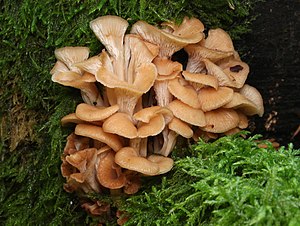Anise counting
| Anise counting | ||||||||||||
|---|---|---|---|---|---|---|---|---|---|---|---|---|

Anise counting ( Lentinellus cochleatus ) |
||||||||||||
| Systematics | ||||||||||||
|
||||||||||||
| Scientific name | ||||||||||||
| Lentinellus cochleatus | ||||||||||||
| ( Pers .: Fr. ) P.Karst. |
The anise-counting ( Lentinellus cochleatus ) is a mushroom from the family of the ear spoon-stinging relatives (Auriscalpiaceae). The fruiting bodies , growing in clusters on rotten wood, are characterized by funnel-shaped hats, tough meat and the smell of aniseed .
features
Macroscopic features
The fruiting bodies are divided into a hat and a stalk that sits centrally to the side . The convex, later funnel-shaped to bag-like cap in young mushrooms is 25–55 (–70) mm wide and wavy. Sometimes several hats have grown together. The edge of the hat, which is rolled up when young and is sharp in the case of older fruiting bodies, is often indented or incised on one side. The upper side is colored leather-yellow to brown-red, the surface is smooth to slightly wrinkled and matt.
The lamellas on the underside of the hat run down the handle, are close together and heavily notched on the cutting edges. Long and short slats are arranged in a mixed manner. The color of the lamellae ranges from whitish to brownish. The spore powder of the anise counting is whitish-cream in color.
The stem is 30–80 (–100) mm long and 4–8 (–10) mm thick. The surface of the full, tough, elastic stem is grooved lengthways, the stem color corresponds to the color of the hat in the upper half. The lower part of the stem is darker, gray to reddish brown. The fruit bodies are grown together in tufts at the base of the stem.
The soft to gristly tough and watery flesh of the mushroom is whitish to pale brown in color. The smell of the mushroom is clearly anise-like, the mild taste also has an aniseed component. A variety of inolens mentioned in the literature has no aniseed odor.
Microscopic features
The rounded, hyaline spores are smooth to finely ornamented and contain a drop of oil. They measure 3.9–5.2 × 3.9–4.7 µm. The cylindrical, four-pore basidia are 20–25 µm long and 5–5.5 µm thick.
Species delimitation and systematics
The anise counting is difficult to confuse with other types of mushrooms due to its typical fruit body shape and characteristic smell. It is the type species of its genus, although its systematic position is still disputed. In 1983 Moser assigned the species to the “porial genera with a lamellar hymenophore ”. She had previously included Singer among the Tricholomataceae , but later excluded from this family. The current assignment to the Auriscalpiaceae goes back to Maas Geesteranus 1963.
Ecology and phenology
The species grows saprobion table on rotten stumps or roots of deciduous trees, especially red beeches ; seldom it also colonizes softwoods. The fructification takes place from July to November.
distribution
The species is distributed almost worldwide. There is evidence from Australia, North Asia (Eastern Siberia, Japan), North and Central America (USA, Canada, Panama) and Europe. In Europe the anise-counting is spread submeridional to boreal . The main area of distribution is in southern Central Europe. The counting has been proven in almost all of Europe. In the south it occurs from Spain to the Ukraine, it is also widespread throughout Western and Central Europe. In northern Europe it can be found all over Fennoscandinavia . In Sweden the species was detected up to the 67th parallel.
In Germany, the anise counting is widespread from the sea coast to the Alps, with areas of agglomeration and loosening alternating.
meaning
The anise-counting is edible , although the literature recommends using it as a seasoning mushroom due to the tough meat and the aniseed taste .
literature
- Josef Breitenbach, Fred Kränzlin (Ed.): Mushrooms of Switzerland. Contribution to knowledge of the fungal flora in Switzerland. Volume 3: Bolete and agaric mushrooms. Part 1: Strobilomycetaceae and Boletaceae, Paxillaceae, Gomphidiacea, Hygrophoracea, Tricholomataceae, Polyporaceae (lamellar). Mykologia, Luzern 1991, ISBN 3-85604-030-7 , p. 204.
- Hans E. Laux: Cosmos mushroom guide for on the go . Kosmos, Stuttgart 2010, ISBN 978-3-440-12408-6 , pp. 452 .
Individual evidence
- ↑ Cvetomir M. Denchev, Boris Assyov: Checklist of the larger basidiomycetes in Bulgaria . In: Mycotaxon . tape 111 , 2010, ISSN 0093-4666 , p. 279–282 ( online [PDF]).
- ^ A b Worldwide distribution of Lentinellus cochleatus. (No longer available online.) In: GBIF Portal / data.gbif.org. Archived from the original on January 2, 2014 ; accessed on January 1, 2014 . Info: The archive link was inserted automatically and has not yet been checked. Please check the original and archive link according to the instructions and then remove this notice.
- ↑ a b German Josef Krieglsteiner (Ed.), Andreas Gminder : Die Großpilze Baden-Württemberg . Volume 3: Mushrooms. Leaf mushrooms I. Ulmer, Stuttgart 2001, ISBN 3-8001-3536-1 , p. 7.
- ↑ Jean-Pierre Prongué, Rudolf Wiederin, Brigitte Wolf: The fungi of the Principality of Liechtenstein . In: Natural history research in the Principality of Liechtenstein . Vol. 21. Vaduz 2004 ( online [PDF]).
- ^ S. Petkovski: National Catalog (Check List) of Species of the Republic of Macedonia . In: Acta Botanica Croatica . 2009 (English, PDF, 1.6MB ( memento from February 15, 2010 in the Internet Archive ) [accessed January 1, 2014]). National Catalog (Check List) of Species of the Republic of Macedonia ( Memento of the original from February 15, 2010 in the Internet Archive ) Info: The archive link has been inserted automatically and has not yet been checked. Please check the original and archive link according to the instructions and then remove this notice.
- ^ Lentinellus cochleatus. Pilzoek database, accessed January 1, 2014 .
- ^ TV Andrianova u. a .: Lentinellus cochleatus. Fungi of Ukraine. In: www.cybertruffle.org.uk/ukrafung/eng. Retrieved January 1, 2014 .
- ↑ NMV Verspreidingsatlas online: Lentinellus cochleatus. In: verspreidingsatlas.nl. Retrieved January 1, 2014 .
